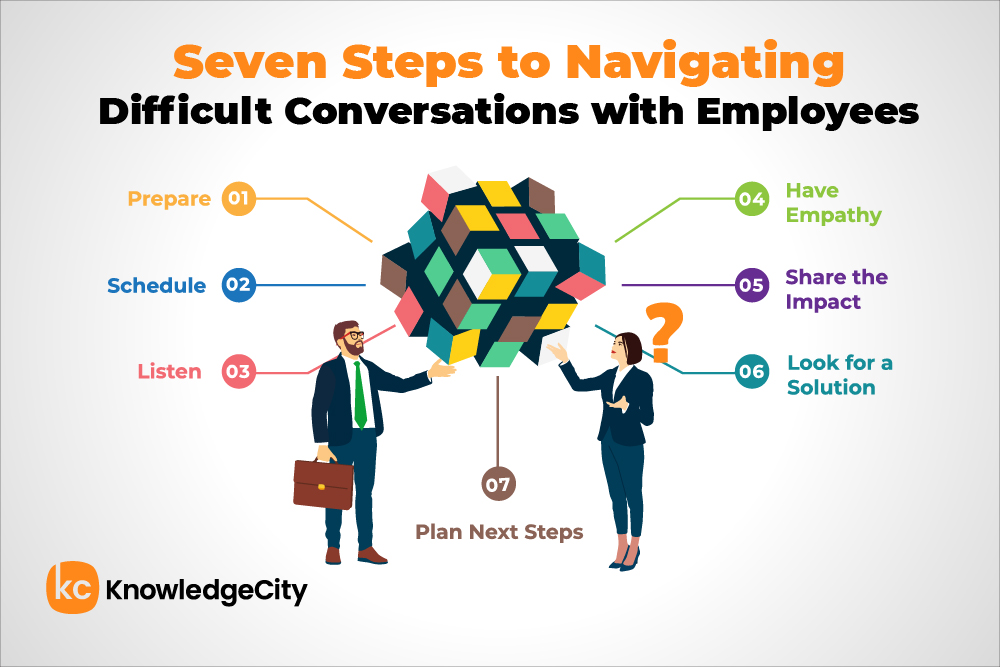There comes a time in every manager’s career when they must have a difficult conversation with an employee. The uncertainty of how to approach touchy subjects in a respectful and non-triggering way is enough to stop even the most experienced managers in their tracks. Some managers may try to avoid having the conversation altogether to prevent any possible outbreak of negative emotions.

Anyone can master challenging employee conversations using these seven steps.
Step 1: Prepare
Having an outline that guides any tough conversations with employees is always helpful. Preparing an outline requires gathering documents and conducting a thorough review of details to assemble talking points. Make talking points and examples fact-based and specific. Center conversations around the employee and their situation and avoid comparing the employee to others.
Step 2: Schedule
Time and place are two critical components for a successful employee meeting. These meetings should occur when the manager and the employee can focus on the conversation without interruption or feeling rushed.
When scheduling, contact the employee and see when the most convenient time is for them to meet with you. Pick a time that allows you both to prepare adequately.
Whenever you’re having difficult conversations with employees, do so in a quiet area to prevent distractions. Optimally, the meeting should be in a private room with a door or a nonpublic space that’s out of earshot of others.
Step 3: Listen
After the employee receives input, listen to them. After all, having a conversation is a two-way experience. It’s important for the employee to have the opportunity to respond to the information, add their own information, and ask questions.
Part of active listening is being engaged in what the other person has to say and asking clarifying questions when appropriate. You can demonstrate active listening by taking notes, asking follow-up questions, or paraphrasing what’s been said to affirm understanding. The employee will usually divulge the reason behind the issues.
Listening with intention will help you solve the issues whenever you’re having hard conversations with employees.
Step 4: Have Empathy
Acknowledging someone as an individual first and an employee second demonstrates empathy. Affirming their feelings often deescalates emotionally charged situations. An employee who feels understood is more likely to communicate openly and honestly.
Demonstrating empathy can be as easy as speaking to the employee respectfully, showing interest in their point of view, or asking thoughtful questions.
According to HR Soul, “If the behaviors are the ‘what,’ then discussing the impact is the ‘why.’” Adopting this mindset can help you during difficult conversations with employees.
Often, employees aren’t aware of how their performance or behavior impacts others. Specific examples of how they’ve affected customers, team members, and the overall business will demonstrate the consequences of their actions, helping them to become more self-aware. If these employees consider their behavior through the eyes of others, it can be a humbling experience. Hopefully, it will inspire them to make corrections.
Step 6: Look for a Solution
Discussing expectations and articulating what success looks like sets the tone for creating solutions. Since employees are usually more determined to support a goal they have a say in, encourage them to share their thoughts and recommendations.
Brainstorming is a great way to engage employees and help them solve the problem. After the options are discussed, both should agree on a solution.
Step 7: Plan Next Steps
Planning the next steps is critical for solidifying the work accomplished in steps one through six. A plan also demonstrates the importance of the employee’s course correction and the manager’s commitment to help. Having a written document is a tangible reminder of the work that needs to be done and outlines how to achieve the improvements.
The plan should include a minimum of five parts:
- The problem statement, which briefly states the reason that prompted the conversation
- The proposed solution
- A chronological outline of the needed actions and resources for achieving the solution
- A deadline for completing goals
- A closeout
A closeout is when you set a date to meet again, provide feedback, and discuss any additional corrections that may need to be made.
One of the most stressful responsibilities of being a manager is having difficult conversations with employees. Instead of dreading the conversation, embrace it. Changing the approach changes the outcome.
Using these seven steps prepares every manager to handle difficult employee conversations successfully.
Subscribe to Our Newsletter
Join 80,000+ Fellow HR Professionals. Get expert recruiting and training tips straight
to your inbox, and become a better HR manager.

 Annette Hooker
Annette Hooker 

